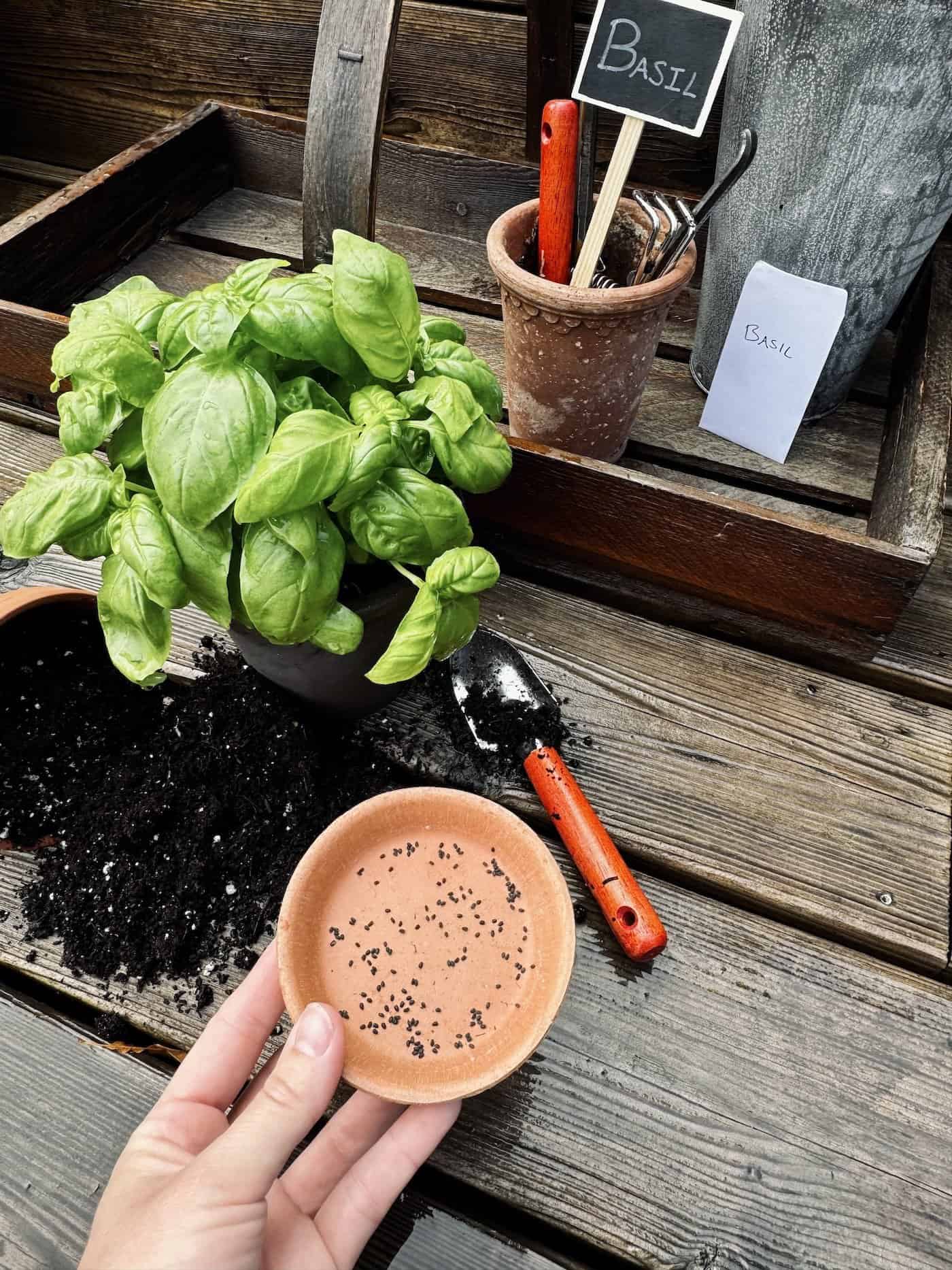
Written by:
| Published:
| Updated:
| In:
Affiliate disclaimer: I sometimes link to products. Please assume these links are affiliate links. If you choose to buy through my links, I might get a commission at no cost to you. Thank you!
While basil starter plants are easy to find in most garden centers and even supermarkets, most of the best varieties in terms of growing ease and flavor need to be grown from seed. While the tiny seeds can be a bit fussy, they can be easy to grow once you understand what they need to germinate.

1. Collecting supplies
You can plant basil seeds in a small planter pot, in a seedling tray, or straight into the outdoor soil (as long as the soil is nice and warm).
If using a planter pot, look for a breathable material like terra cotta or unglazed ceramic. It should also have a drainage hole in the bottom. Seedling trays are usually plastic of some kind, and include drainage holes. If planting your seeds directly in outdoor soil, choose a location with lots of direct sunlight and hopefully with soil that does not tend to get waterlogged.
For seed-starting in pots or seedling trays, you’ll need high-quality potting soil. A seed starting mix is ideal, but regular potting soils also work well. Moisten the soil in a large pot before getting started with planting your basil seeds.
2. Prep the soil
Moisten your potting mix. Fill the pot or seedling trays with potting mix, leaving a little bit of room. Gently compress the soil with your fingers.
If planting in outdoor soil, start by digging out any weeds, dead plants, and large rocks. Remove any plant debris and rake the surface flat. You can also apply a thin layer of compost over the soil surface (homemade compost made from your composted yard waste is best).

3. Plant the basil seeds
When you’re ready to plant, sprinkle the basil seeds evenly across the soil surface. Basil seeds are small, so be careful not to put too many in each pot or tray insert slot. I generally put about 3 in each little pot. You can use a pencil or seeding tool if the seeds are too small for you to work with.
After spreading the seeds, gently press them into the soil with your fingers or a flat object, and lightly cover them with a thin layer of soil by gently sprinkling the potting mix overtop.

4. Water the planted seeds
Water the soil gently to ensure it’s evenly moist, trying your best not to dislodge the tiny seeds to much. Watch to make sure the extra water is draining away.
5. Keep the planted seeds warm and moist
Basil seeds germinate best in warm soil. If growing indoors, you can put the pots/trays on a seedling heat mat or on a heated floor to help them sprout more quickly. Outdoors, it’s ideal to plant them after the last frost when temperatures are consistently above 70°F.
Keep the soil consistently moist during the germination period, which usually takes 7-10 days. You can cover the pot or garden bed with a clear plastic cover or a plastic bag to create a greenhouse effect, retaining moisture and warmth.
6. Caring for seedling
Once the seeds sprout and the seedlings are a few inches tall, remove any coverings used during germination. As the seedlings grow, thin them out to give each plant enough space to develop. Usually about 6 inches apart is enough, but there are some larger varieties (so check your seed packet.
As your basil plants mature, continue to water them regularly, keeping the soil moist but not waterlogged. Basil is a fast-growing herb, and with proper care, you’ll have fresh leaves ready to harvest in just a few weeks.
To encourage bushier growth, pinch off the top leaves regularly. Remove any flowers that start to form, as flowering can cause the plant to produce fewer leaves. But if you want to collect your own basil seeds, let the plant flower away!






